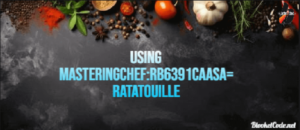Introduction
In the world of IT infrastructure, mastering Chef is akin to mastering a complex dish like Ratatouille. But what does Mastering Chef:rb6391caasa= ratatouille mean?
Understanding this identifier is key to streamlining your configuration management and automating infrastructure.
This article dives into the depths of Mastering Chef: rb6391caasa = Ratatouille, showcasing how this unique blend of technology and metaphor can transform your approach to infrastructure management.
What is a Masteringchef:rb6391caasa= ratatouille?
Chef is a powerful configuration management tool that automates the process of managing and deploying servers.
With Chef, you can define your infrastructure as code, allowing for consistent and repeatable configurations.
The essence of Mastering Chef: rb6391caasa = Ratatouille lies in understanding how a Chef operates, much like how a chef in the kitchen must understand the intricacies of blending flavors in a Ratatouille.
Understanding Masteringchef:rb6391caasa= ratatouille
The identifier “rb6391caasa” serves as a symbolic representation of the intricacies within Chef’s configuration management system.
It might represent a unique resource, a specific version, or a component within a larger setup.
In the context of Mastering chef: rb6391caasa = Ratatouille, it’s essential to comprehend how these unique identifiers play a role in tracking and managing your infrastructure’s different components.
The Art of Mastering Chef:rb6391caasa= ratatouille
Mastering chef: rb6391caasa = Ratatouille is more than just a catchy phrase.
It encapsulates the essence of what Chef does—bringing together various components and configurations to create a harmonious, well-orchestrated infrastructure, much like how a chef creates a Ratatouille.
Chef simplifies the complex process of managing diverse environments and resources, allowing you to automate and manage your infrastructure effortlessly.
Setting Up Mastering Chef:rb6391caasa= ratatouille for Beginners
If you’re new to Chef and the concept of Mastering chef: rb6391caasa = Ratatouille, here’s how to get started:
- Install Chef: Download the Chef Development Kit (ChefDK) to your system.
- Initial Configuration: Set up your Chef workstation, and connect to the Chef server.
- Create a Basic Recipe: Write a simple recipe to understand the basics of Chef’s syntax and structure.
Mastering the Basics of Chef
To truly master Chef, you need to grasp its core components:
- Cookbooks: Collections of recipes and resources that define the desired state of your system.
- Recipes: These scripts specify the steps to configure your infrastructure.
- Resources: Define the desired state of different parts of your system, such as packages, services, or files.
By understanding how these elements interact, you can begin to see how Mastering chef: rb6391caasa = Ratatouille becomes a reality, where each component plays a vital role in the overall configuration.
Diving Deeper: Chef’s Advanced Features
Chef’s true power lies in its advanced features, which include:
- Automation: Chef allows for automating complex tasks and processes across large-scale environments.
- Cloud Integration: Chef integrates with cloud platforms like AWS, Azure, and Google Cloud, enhancing the efficiency of managing cloud infrastructure.
These advanced capabilities make Mastering chef: rb6391caasa = Ratatouille not just an achievable goal but a transformative practice in how you manage your infrastructure.
Using Mastering Chef:rb6391caasa= ratatouille

Implementing “rb6391caasa” in your Chef workflow allows for a more organized and efficient approach to configuration management.
For example, using unique identifiers helps track changes, manage dependencies, and maintain consistency across multiple environments.
This concept is at the heart of “Mastering Chef: rb6391caasa = Ratatouille,” where every element is precisely managed and orchestrated.
Automating Infrastructure with Mastering Chef:rb6391caasa= ratatouille
Chef enables you to define and manage your infrastructure as code. By using this approach, you can automate the deployment, configuration, and management of your servers.
This is the essence of “Mastering chef: rb6391caasa = Ratatouille,” where automation is key to achieving a well-balanced and efficient infrastructure.
Mastering Chef:rb6391caasa= ratatouille’s Role in Continuous Delivery
Continuous delivery is about automating the release process to ensure that software can be reliably released at any time.
Chef’s role in this is crucial—it provides the tools needed to automate the configuration and deployment of applications.
“Mastering chef: rb6391caasa = Ratatouille” means using Chef to create a seamless, automated pipeline that gets your product to users faster and with fewer errors.
Troubleshooting Common Issues in Mastering Chef:rb6391caasa= ratatouille
No journey to “Mastering chef: rb6391caasa = Ratatouille” is without its challenges. Common issues you might encounter include:
- Dependency Conflicts: Ensure proper versioning and manage dependencies to avoid conflicts.
- Resource Failures: Verify that resources are correctly defined and necessary conditions are met.
- Performance Issues: Optimize slow-running recipes using Chef’s profiling tools.
Mastering Chef:rb6391caasa= ratatouille Community and Resources
To become proficient in “Mastering Chef: rb6391caasa = Ratatouille,” engaging with the Chef community is invaluable.
The community offers a wealth of resources, including forums, documentation, and tutorials.
This support network can help you troubleshoot, learn new techniques, and stay updated with the latest advancements in Chef.
Future of Mastering Chef:rb6391caasa= ratatouille
As you delve deeper into “Mastering chef: rb6391caasa = Ratatouille,” it’s essential to keep an eye on the future of configuration management.
Trends such as immutable infrastructure, serverless architectures, and AI-driven automation are shaping the next generation of infrastructure management tools.
Chef continues to evolve, ensuring it remains a relevant and powerful tool in this changing landscape.
Conclusion
“Mastering Chef: rb6391caasa = Ratatouille” is more than just a catchy phrase—it’s a guide to simplifying the complexity of infrastructure management.
By learning to use Chef effectively, you can automate processes, ensure consistency, and achieve a more reliable IT environment.
Whether you’re integrating with cloud services, automating infrastructure, or implementing continuous delivery, mastering Chef is a game-changer.
FAQs
What makes Chef different from other configuration management tools
Chef uses a Ruby-based DSL for more flexibility and integrates well with various cloud and DevOps tools, making it unique in its approach to automation.
How can I start learning Chef as a beginner?
Begin with the official Chef documentation and tutorials. Practice by setting up a test environment and creating simple recipes to get hands-on experience.
What is the significance of “rb6391caasa” in Chef?
“rb6391caasa” can be seen as a unique identifier within Chef, crucial for tracking and managing various infrastructure components, emphasizing the detailed control Chef offers.
How does Chef integrate with cloud services?
Chef integrates with cloud platforms like AWS, Azure, and Google Cloud, providing automated management of cloud resources, which is a key aspect of mastering Chef.
Is Chef suitable for small-scale projects?
Absolutely. Chef is scalable and can be used effectively for both small-scale and large-scale projects, offering flexibility and control at any scale.

